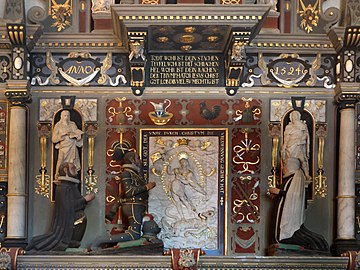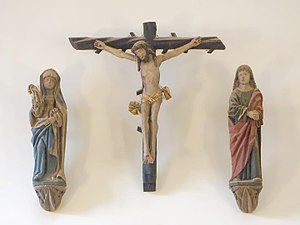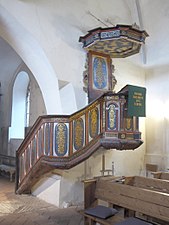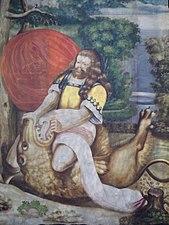Basedow Church (Mecklenburg)
The Basedow Church is a village church in Basedow dating back to the 13th century , which contains several ornate historical epitaphs of the Hahn family , who lived in the nearby Basedow Castle . The parish belongs to the Rostock provost in the Mecklenburg parish of the Evangelical Lutheran Church in Northern Germany (Northern Church) .
history
Since 1247 the Basedower Church was a daughter church of Malchin . The oldest part of the church is the rectangular, east-facing choir . It was built from field stones in the 13th century . In the 15th century, the extension was made with a wider, three-bay brick nave . The first evangelical pastor was Stephan Holste. In 1577 he signed the formula of the Concord. The elaborate interior design dates from this time.
The tower of the church caught fire when a nearby farmer's cottage caught fire in 1766, destroying the wooden spire, clockwork and bells. During the subsequent renovation, the tower was given a simple finish with a transverse hipped roof. Today's neo-Gothic tower was built in 1853 based on a design by Friedrich August Stüler , who renovated the church from 1834. The paving of the floor, the current shape of the 16th century crypt extension on the north wall of the choir, as well as the porches and the portal in the wall of the churchyard come from Stüler.
The bells destroyed in 1766 were initially replaced by a single bell on a belfry placed next to the church. In 1843, the bell founder Johann Carl Ludwig Illies in Waren bought new bells, but the larger ones were melted down in 1917. The smaller bell from 1843 with a diameter of 83 cm has been preserved to this day. In 1926 the ringing was completed by two new bells with diameters of 85 and 131 cm.
The theologian Georg Matthias Wüstney (1756–1822) was pastor in Basedow from 1783 until his death. He earned services to the upbringing and education of young people and founded the Wüstney Institute .
While the neighboring castle was looted at the end of World War II, the church was largely spared from destruction. The organ was rebuilt and rearranged several times over the years, but it was brought back to its original shape and position during a comprehensive restoration between 1980 and 1983 by the Schuke company .
Vault
The entire church is vaulted. The three-bay nave has a ribbed vault , while the choir shows a groin vault .
Furnishing
Altarpiece
On the east wall of the choir is an architecturally designed altarpiece made of sandstone from 1592. It rests on Tuscan columns. Recessed marble reliefs on the middle floor show the Last Supper, the crucifixion and the resurrection of Christ. There are also eight colored coats of arms of the founders, the cousins Kuno (1525–1590), Werner († 1593) and Joachim († 1589) Hahn, as well as Werner's son Hans († 1633) and their wives, as well as inscriptions. Statuettes of the four evangelists carry the upper structure with further allegorical figures and a relief for the Ascension of Christ. Another relief is on the predella . There Jesus is depicted in Gethsemane . The altarpiece and the epitaphs are attributed to the workshop of Claus Midow .
Epitaphs and tombstones
Ornate epitaphs , mostly made of painted sandstone, date from the end of the 16th century . The richest figural decoration is shown in the painted sandstone epitaph from 1594 on the north choir wall by Hans Hahn for his parents Werner Hahn and Anna von der Lühe , which shows a marble relief of the triumphant Christ in the center, in front of which three almost life-size colored figures kneel (the two Deceased and the founder) and that is surrounded by other figures and coats of arms. Other ornate epitaphs recall Berndt von der Schulenburg and Anna Hahn , Guedel von Maltzan († 1575), Kuno Hahn († 1590) and Sophia von der Schulenburg († 1591). The associated grave slabs erected on the south wall of the church were originally in the ground above the tombs. There is also an epitaph for Paris Hahn sen. On the west side of the choir room. († 1565) and Paris Hahn jun. († 1587) received.
Triumphal Cross Group
A triumphal cross group can be seen above the opening of the triumphal arch : Mary and the evangelist John under the cross of Jesus. The figures from the 15th century are among the oldest works of art in the church.
pulpit
The wooden pulpit from 1691 does not show any figurative decoration. Instead we find floral motifs in the fields of stairs and corpus. In the octagonal corpus, the fields are framed by columns and round arches. The octagonal sound cover with cornice cranks is also decorated with flowers .
The church's furnishings also include the baptism from the 17th century, painted with depictions of the apostles, as well as various panel paintings and historical cabinet doors, which are painted with motifs from salvation history.
organ
The one on the 1615 built loft located organ is the oldest preserved Baroque organ in Mecklenburg. Instead of an older instrument, it was built between 1680 and 1683 by order of Christian Friedrich Hahn by master organ builders Heinrich Herbst (father and son) from Magdeburg and Samuel Gercke from Güstrow . By comparing manuscripts from the organ file, the latest research confirms that Arp Schnitger, probably the most famous organ builder of his time in northern Germany, was involved .
According to a report by the Rostock organ builder Paul Schmidt , which was drawn up as early as 1755, the organ was in a poor condition . This was followed by the first modifications, further repairs were carried out in 1842 by Carl Noebe from Güstrow, in 1890 by Edmund Bruder (Wismar) and in 1905 by Carl Börger (Gehlsdorf near Rostock). From 1980 to 1983 a restoration and reconstruction of the almost unplayable organ was carried out by VEB Schuke-Orgelbau (Potsdam). In 2012 a comprehensive on-site restoration was carried out in the Basedower church by the Wegscheider organ workshop (Dresden).
The organ and the parapet of the gallery form an artistic ensemble with rich fittings, coats of arms and allegorical figures. The organ prospect can be closed with painted wings or canvas curtains for soundproofing during Lent. On the substructure of the two pedal towers there are two so-called “Basedower lions”, lion-head-like relief masks that stick out their tongues and roll their eyes when the register pull Principal 16 'is operated. The disposition is as follows:
|
|
|
|
||||||||||||||||||||||||||||||||||||||||||||||||||||||||||||||||||||||||||||||||||||||||||||||||||||||||||||||||||||||||
- Pairing : I / II
Churchyard
In the churchyard there is a burial place of those von Hahn-Basedow: Friedrich Franz Graf von Hahn-Basedow (born February 28, 1859, † March 21, 1916), hereditary land marshal; his wife Therese Countess von Hahn-Basedow (born August 26, 1859, † February 4, 1928), née Countess Henckel-Donnersmarck ; Renata Countess Hahn von Burgsdorff (born January 9, 1913 - January 28, 2000) born Countess von Hochberg , baroness of Fürstenstein-Liepen; u. a.
literature
- Georg Dehio : Basedow, district authority Demmin. In: Handbook of German Art Monuments, Mecklenburg-Western Pomerania. Munich, Berlin 2000 ISBN 3-422-03081-6 pp. 50-52.
- Friedrich Schlie : The art and history monuments of the Grand Duchy of Mecklenburg-Schwerin. Volume 5: The district courts of Teterow, Malchin, Stavenhagen, Penzlin, Waren, Malchow and Röbel. Schwerin 1902 ISBN 3-910179-09-6 pp. 118-135.
- Basedow - church and organ. Peda art guide No. 399, Passau 2002.
- The architectural and art monuments of the GDR - Neubrandenburg district. Institute for Monument Preservation, Berlin 1982.
Individual evidence
- ↑ PDF page 130
- ^ Michael Bischoff and Hillert Ibbeken: Renaissance in Mecklenburg. Berlin: BWV 2011 ISBN 978-3-8305-1906-5 , p. 42
- ↑ Peter Golon: And yet it was! Schnitger and Basedow , accessed February 13, 2018.
- ^ Max Reinhard Jaehn: Organs in Mecklenburg. Hinstorff, Rostock 2008, ISBN 978-3-356-01267-5 , pp. 20–31.
- ↑ Beatrix Dräger-Kneißl: Basedow, district of Mecklenburg Lake District, church, organ. In: KulturERBE in Mecklenburg and Western Pomerania. Volume 8/2012, Schwerin 2014, ISBN 978-3-935770-42-2 , pp. 174-175.
- ↑ kirchengemeinde-gielow.de: Information on the organ , accessed on February 13, 2018.
- ↑ Greifenberger Institut für Musikinstrumentenkunde: Basedow ( Memento of the original from April 10, 2017 in the Internet Archive ) Info: The archive link was inserted automatically and has not yet been checked. Please check the original and archive link according to the instructions and then remove this notice. , accessed February 13, 2018.
Web links
Coordinates: 53 ° 41 ′ 45.3 " N , 12 ° 40 ′ 44.1" E














